Economics Report: Market Analysis of the Australian Banking Sector
VerifiedAdded on 2023/04/19
|7
|1798
|118
Report
AI Summary
This report provides a comprehensive market analysis of the Australian banking industry, focusing on the Commonwealth Bank of Australia. It identifies the key determinants of demand and supply for home loans, including mortgage rates, prevailing rent levels, regulatory costs, and bank reserve requirements. The report also examines the impact of emerging FinTechs and new technologies on the Australian banking industry, highlighting increased competition, improved market efficiency, and changes in market prices and quantities. The analysis considers the oligopolistic nature of the Australian banking sector and the effects of recent regulatory changes aimed at fostering competition and innovation. The report concludes that technological advancements have led to lower production costs, potentially resulting in lower market prices and increased market share for Australian banks.
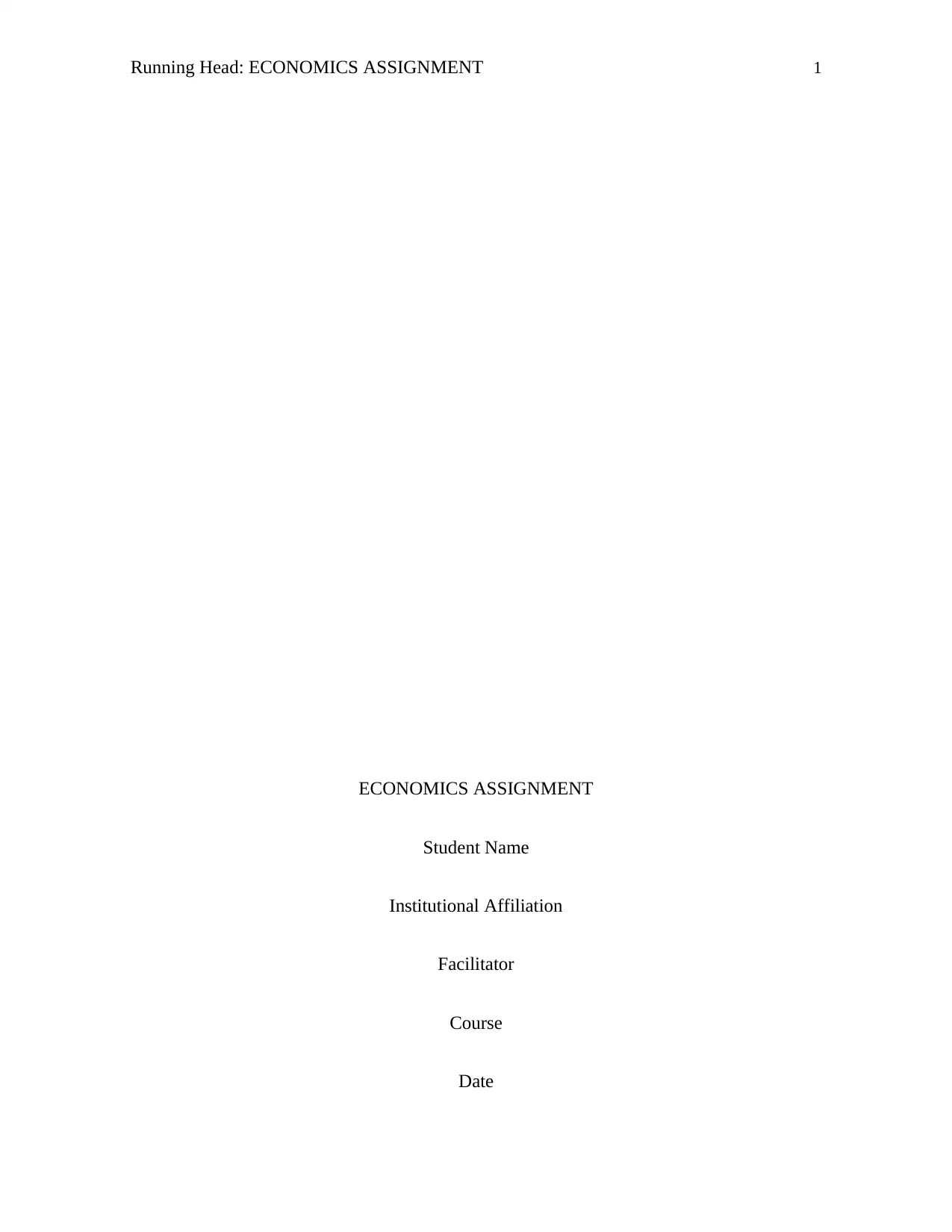
Running Head: ECONOMICS ASSIGNMENT 1
ECONOMICS ASSIGNMENT
Student Name
Institutional Affiliation
Facilitator
Course
Date
ECONOMICS ASSIGNMENT
Student Name
Institutional Affiliation
Facilitator
Course
Date
Paraphrase This Document
Need a fresh take? Get an instant paraphrase of this document with our AI Paraphraser
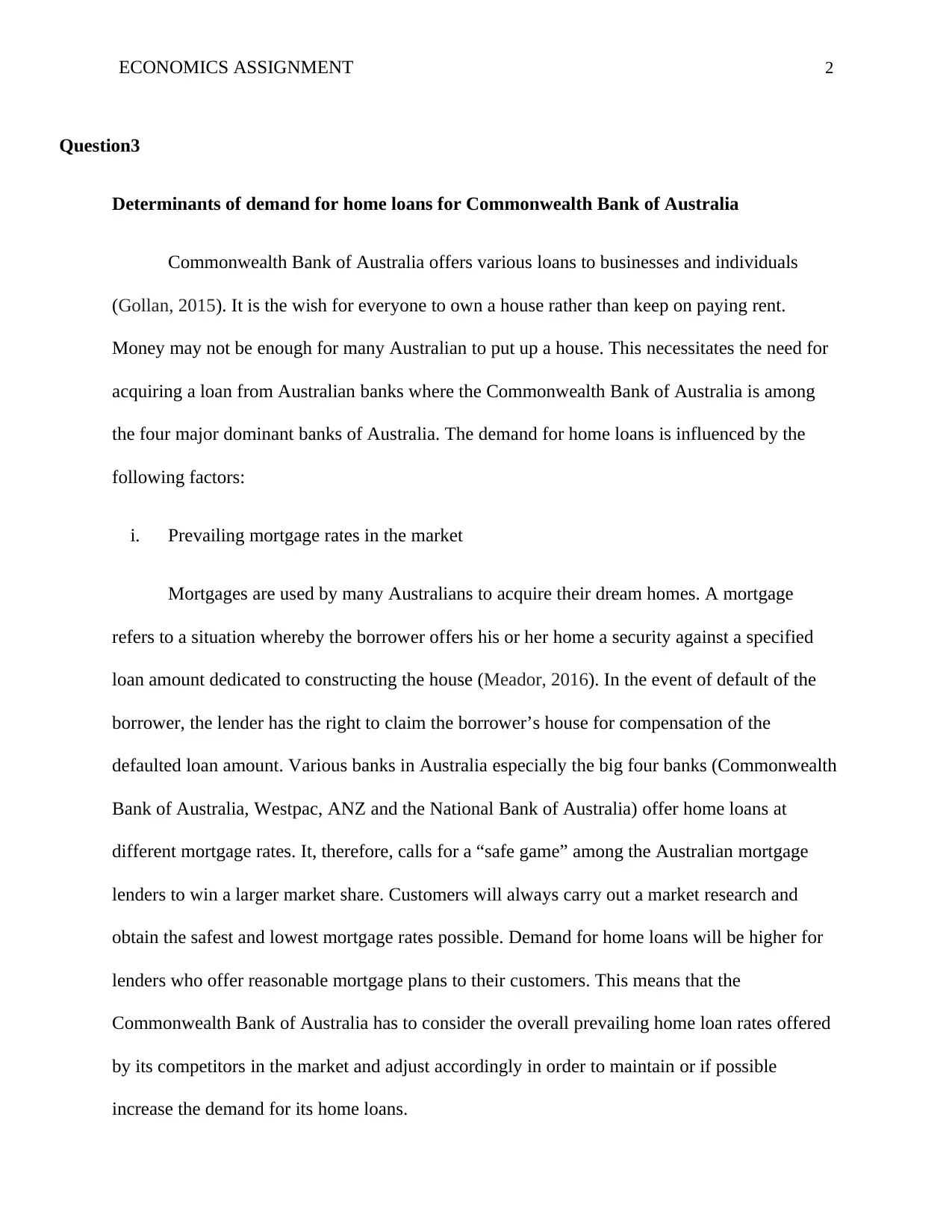
ECONOMICS ASSIGNMENT 2
Question3
Determinants of demand for home loans for Commonwealth Bank of Australia
Commonwealth Bank of Australia offers various loans to businesses and individuals
(Gollan, 2015). It is the wish for everyone to own a house rather than keep on paying rent.
Money may not be enough for many Australian to put up a house. This necessitates the need for
acquiring a loan from Australian banks where the Commonwealth Bank of Australia is among
the four major dominant banks of Australia. The demand for home loans is influenced by the
following factors:
i. Prevailing mortgage rates in the market
Mortgages are used by many Australians to acquire their dream homes. A mortgage
refers to a situation whereby the borrower offers his or her home a security against a specified
loan amount dedicated to constructing the house (Meador, 2016). In the event of default of the
borrower, the lender has the right to claim the borrower’s house for compensation of the
defaulted loan amount. Various banks in Australia especially the big four banks (Commonwealth
Bank of Australia, Westpac, ANZ and the National Bank of Australia) offer home loans at
different mortgage rates. It, therefore, calls for a “safe game” among the Australian mortgage
lenders to win a larger market share. Customers will always carry out a market research and
obtain the safest and lowest mortgage rates possible. Demand for home loans will be higher for
lenders who offer reasonable mortgage plans to their customers. This means that the
Commonwealth Bank of Australia has to consider the overall prevailing home loan rates offered
by its competitors in the market and adjust accordingly in order to maintain or if possible
increase the demand for its home loans.
Question3
Determinants of demand for home loans for Commonwealth Bank of Australia
Commonwealth Bank of Australia offers various loans to businesses and individuals
(Gollan, 2015). It is the wish for everyone to own a house rather than keep on paying rent.
Money may not be enough for many Australian to put up a house. This necessitates the need for
acquiring a loan from Australian banks where the Commonwealth Bank of Australia is among
the four major dominant banks of Australia. The demand for home loans is influenced by the
following factors:
i. Prevailing mortgage rates in the market
Mortgages are used by many Australians to acquire their dream homes. A mortgage
refers to a situation whereby the borrower offers his or her home a security against a specified
loan amount dedicated to constructing the house (Meador, 2016). In the event of default of the
borrower, the lender has the right to claim the borrower’s house for compensation of the
defaulted loan amount. Various banks in Australia especially the big four banks (Commonwealth
Bank of Australia, Westpac, ANZ and the National Bank of Australia) offer home loans at
different mortgage rates. It, therefore, calls for a “safe game” among the Australian mortgage
lenders to win a larger market share. Customers will always carry out a market research and
obtain the safest and lowest mortgage rates possible. Demand for home loans will be higher for
lenders who offer reasonable mortgage plans to their customers. This means that the
Commonwealth Bank of Australia has to consider the overall prevailing home loan rates offered
by its competitors in the market and adjust accordingly in order to maintain or if possible
increase the demand for its home loans.
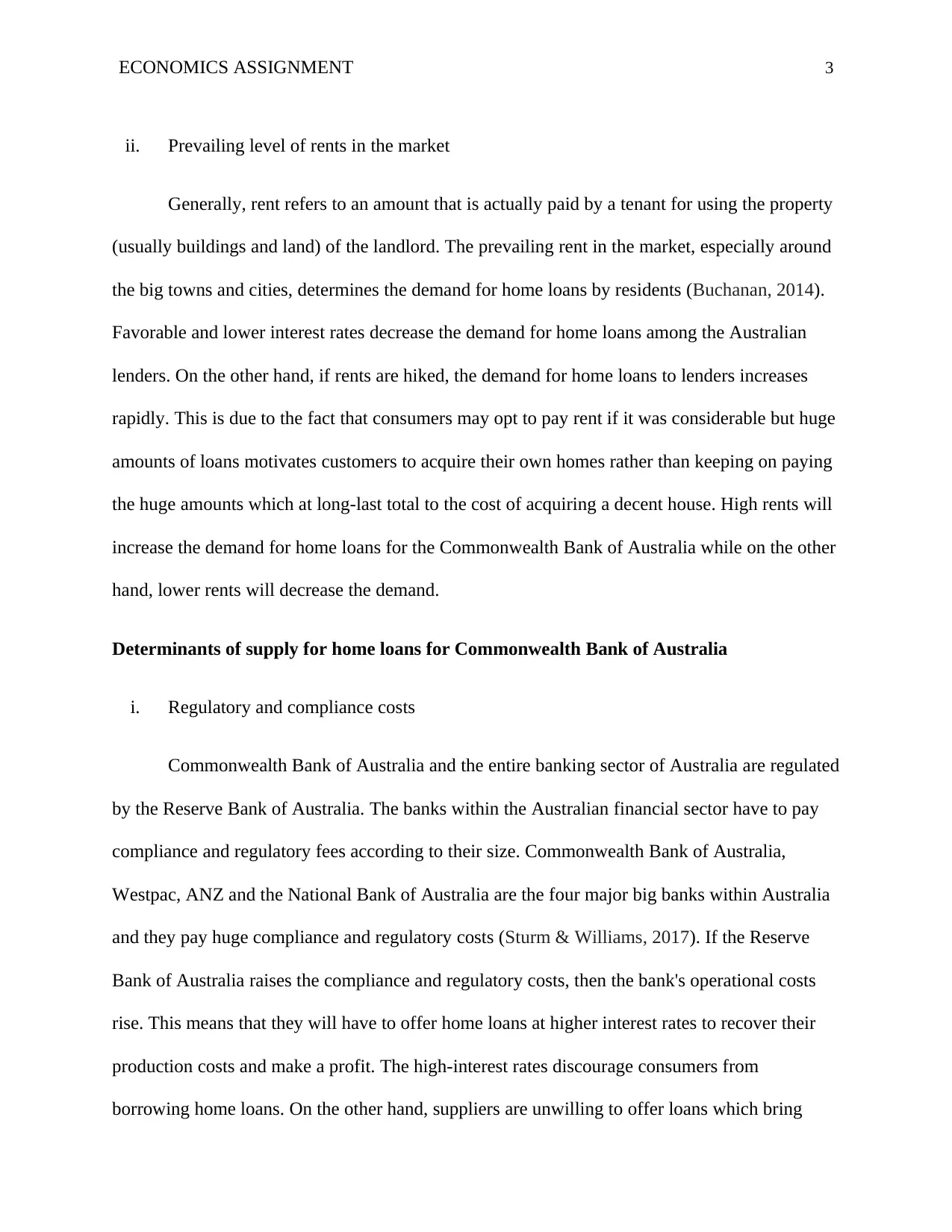
ECONOMICS ASSIGNMENT 3
ii. Prevailing level of rents in the market
Generally, rent refers to an amount that is actually paid by a tenant for using the property
(usually buildings and land) of the landlord. The prevailing rent in the market, especially around
the big towns and cities, determines the demand for home loans by residents (Buchanan, 2014).
Favorable and lower interest rates decrease the demand for home loans among the Australian
lenders. On the other hand, if rents are hiked, the demand for home loans to lenders increases
rapidly. This is due to the fact that consumers may opt to pay rent if it was considerable but huge
amounts of loans motivates customers to acquire their own homes rather than keeping on paying
the huge amounts which at long-last total to the cost of acquiring a decent house. High rents will
increase the demand for home loans for the Commonwealth Bank of Australia while on the other
hand, lower rents will decrease the demand.
Determinants of supply for home loans for Commonwealth Bank of Australia
i. Regulatory and compliance costs
Commonwealth Bank of Australia and the entire banking sector of Australia are regulated
by the Reserve Bank of Australia. The banks within the Australian financial sector have to pay
compliance and regulatory fees according to their size. Commonwealth Bank of Australia,
Westpac, ANZ and the National Bank of Australia are the four major big banks within Australia
and they pay huge compliance and regulatory costs (Sturm & Williams, 2017). If the Reserve
Bank of Australia raises the compliance and regulatory costs, then the bank's operational costs
rise. This means that they will have to offer home loans at higher interest rates to recover their
production costs and make a profit. The high-interest rates discourage consumers from
borrowing home loans. On the other hand, suppliers are unwilling to offer loans which bring
ii. Prevailing level of rents in the market
Generally, rent refers to an amount that is actually paid by a tenant for using the property
(usually buildings and land) of the landlord. The prevailing rent in the market, especially around
the big towns and cities, determines the demand for home loans by residents (Buchanan, 2014).
Favorable and lower interest rates decrease the demand for home loans among the Australian
lenders. On the other hand, if rents are hiked, the demand for home loans to lenders increases
rapidly. This is due to the fact that consumers may opt to pay rent if it was considerable but huge
amounts of loans motivates customers to acquire their own homes rather than keeping on paying
the huge amounts which at long-last total to the cost of acquiring a decent house. High rents will
increase the demand for home loans for the Commonwealth Bank of Australia while on the other
hand, lower rents will decrease the demand.
Determinants of supply for home loans for Commonwealth Bank of Australia
i. Regulatory and compliance costs
Commonwealth Bank of Australia and the entire banking sector of Australia are regulated
by the Reserve Bank of Australia. The banks within the Australian financial sector have to pay
compliance and regulatory fees according to their size. Commonwealth Bank of Australia,
Westpac, ANZ and the National Bank of Australia are the four major big banks within Australia
and they pay huge compliance and regulatory costs (Sturm & Williams, 2017). If the Reserve
Bank of Australia raises the compliance and regulatory costs, then the bank's operational costs
rise. This means that they will have to offer home loans at higher interest rates to recover their
production costs and make a profit. The high-interest rates discourage consumers from
borrowing home loans. On the other hand, suppliers are unwilling to offer loans which bring
⊘ This is a preview!⊘
Do you want full access?
Subscribe today to unlock all pages.

Trusted by 1+ million students worldwide
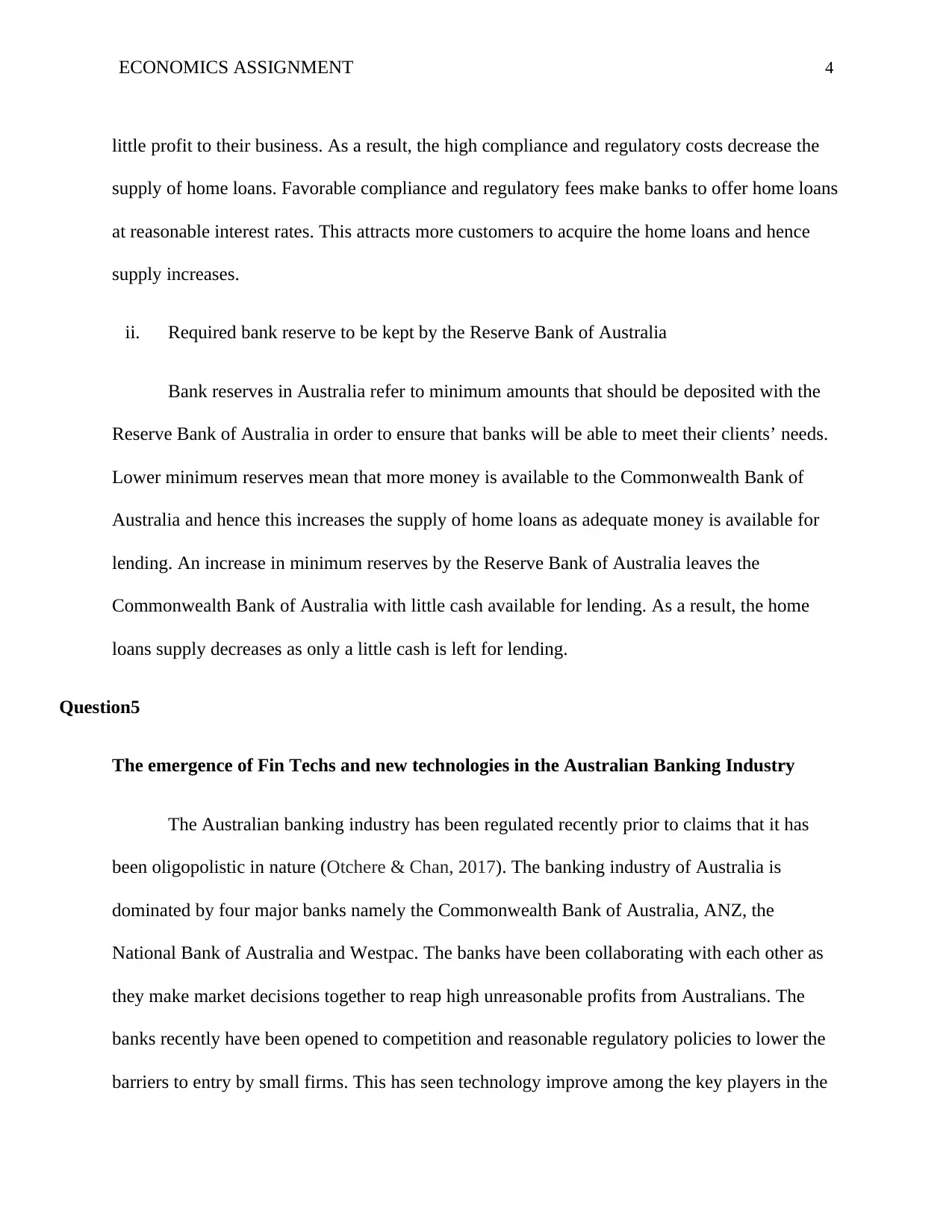
ECONOMICS ASSIGNMENT 4
little profit to their business. As a result, the high compliance and regulatory costs decrease the
supply of home loans. Favorable compliance and regulatory fees make banks to offer home loans
at reasonable interest rates. This attracts more customers to acquire the home loans and hence
supply increases.
ii. Required bank reserve to be kept by the Reserve Bank of Australia
Bank reserves in Australia refer to minimum amounts that should be deposited with the
Reserve Bank of Australia in order to ensure that banks will be able to meet their clients’ needs.
Lower minimum reserves mean that more money is available to the Commonwealth Bank of
Australia and hence this increases the supply of home loans as adequate money is available for
lending. An increase in minimum reserves by the Reserve Bank of Australia leaves the
Commonwealth Bank of Australia with little cash available for lending. As a result, the home
loans supply decreases as only a little cash is left for lending.
Question5
The emergence of Fin Techs and new technologies in the Australian Banking Industry
The Australian banking industry has been regulated recently prior to claims that it has
been oligopolistic in nature (Otchere & Chan, 2017). The banking industry of Australia is
dominated by four major banks namely the Commonwealth Bank of Australia, ANZ, the
National Bank of Australia and Westpac. The banks have been collaborating with each other as
they make market decisions together to reap high unreasonable profits from Australians. The
banks recently have been opened to competition and reasonable regulatory policies to lower the
barriers to entry by small firms. This has seen technology improve among the key players in the
little profit to their business. As a result, the high compliance and regulatory costs decrease the
supply of home loans. Favorable compliance and regulatory fees make banks to offer home loans
at reasonable interest rates. This attracts more customers to acquire the home loans and hence
supply increases.
ii. Required bank reserve to be kept by the Reserve Bank of Australia
Bank reserves in Australia refer to minimum amounts that should be deposited with the
Reserve Bank of Australia in order to ensure that banks will be able to meet their clients’ needs.
Lower minimum reserves mean that more money is available to the Commonwealth Bank of
Australia and hence this increases the supply of home loans as adequate money is available for
lending. An increase in minimum reserves by the Reserve Bank of Australia leaves the
Commonwealth Bank of Australia with little cash available for lending. As a result, the home
loans supply decreases as only a little cash is left for lending.
Question5
The emergence of Fin Techs and new technologies in the Australian Banking Industry
The Australian banking industry has been regulated recently prior to claims that it has
been oligopolistic in nature (Otchere & Chan, 2017). The banking industry of Australia is
dominated by four major banks namely the Commonwealth Bank of Australia, ANZ, the
National Bank of Australia and Westpac. The banks have been collaborating with each other as
they make market decisions together to reap high unreasonable profits from Australians. The
banks recently have been opened to competition and reasonable regulatory policies to lower the
barriers to entry by small firms. This has seen technology improve among the key players in the
Paraphrase This Document
Need a fresh take? Get an instant paraphrase of this document with our AI Paraphraser
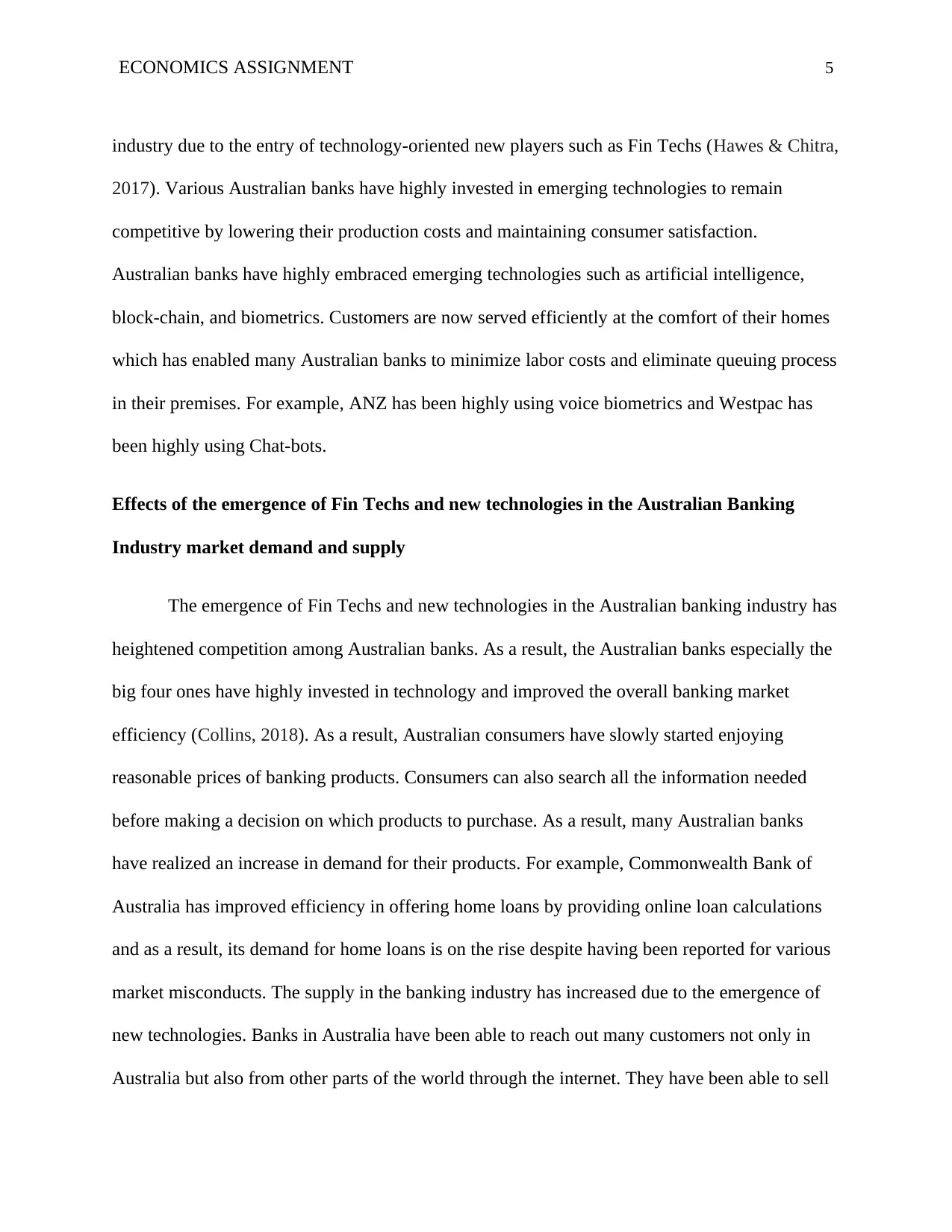
ECONOMICS ASSIGNMENT 5
industry due to the entry of technology-oriented new players such as Fin Techs (Hawes & Chitra,
2017). Various Australian banks have highly invested in emerging technologies to remain
competitive by lowering their production costs and maintaining consumer satisfaction.
Australian banks have highly embraced emerging technologies such as artificial intelligence,
block-chain, and biometrics. Customers are now served efficiently at the comfort of their homes
which has enabled many Australian banks to minimize labor costs and eliminate queuing process
in their premises. For example, ANZ has been highly using voice biometrics and Westpac has
been highly using Chat-bots.
Effects of the emergence of Fin Techs and new technologies in the Australian Banking
Industry market demand and supply
The emergence of Fin Techs and new technologies in the Australian banking industry has
heightened competition among Australian banks. As a result, the Australian banks especially the
big four ones have highly invested in technology and improved the overall banking market
efficiency (Collins, 2018). As a result, Australian consumers have slowly started enjoying
reasonable prices of banking products. Consumers can also search all the information needed
before making a decision on which products to purchase. As a result, many Australian banks
have realized an increase in demand for their products. For example, Commonwealth Bank of
Australia has improved efficiency in offering home loans by providing online loan calculations
and as a result, its demand for home loans is on the rise despite having been reported for various
market misconducts. The supply in the banking industry has increased due to the emergence of
new technologies. Banks in Australia have been able to reach out many customers not only in
Australia but also from other parts of the world through the internet. They have been able to sell
industry due to the entry of technology-oriented new players such as Fin Techs (Hawes & Chitra,
2017). Various Australian banks have highly invested in emerging technologies to remain
competitive by lowering their production costs and maintaining consumer satisfaction.
Australian banks have highly embraced emerging technologies such as artificial intelligence,
block-chain, and biometrics. Customers are now served efficiently at the comfort of their homes
which has enabled many Australian banks to minimize labor costs and eliminate queuing process
in their premises. For example, ANZ has been highly using voice biometrics and Westpac has
been highly using Chat-bots.
Effects of the emergence of Fin Techs and new technologies in the Australian Banking
Industry market demand and supply
The emergence of Fin Techs and new technologies in the Australian banking industry has
heightened competition among Australian banks. As a result, the Australian banks especially the
big four ones have highly invested in technology and improved the overall banking market
efficiency (Collins, 2018). As a result, Australian consumers have slowly started enjoying
reasonable prices of banking products. Consumers can also search all the information needed
before making a decision on which products to purchase. As a result, many Australian banks
have realized an increase in demand for their products. For example, Commonwealth Bank of
Australia has improved efficiency in offering home loans by providing online loan calculations
and as a result, its demand for home loans is on the rise despite having been reported for various
market misconducts. The supply in the banking industry has increased due to the emergence of
new technologies. Banks in Australia have been able to reach out many customers not only in
Australia but also from other parts of the world through the internet. They have been able to sell
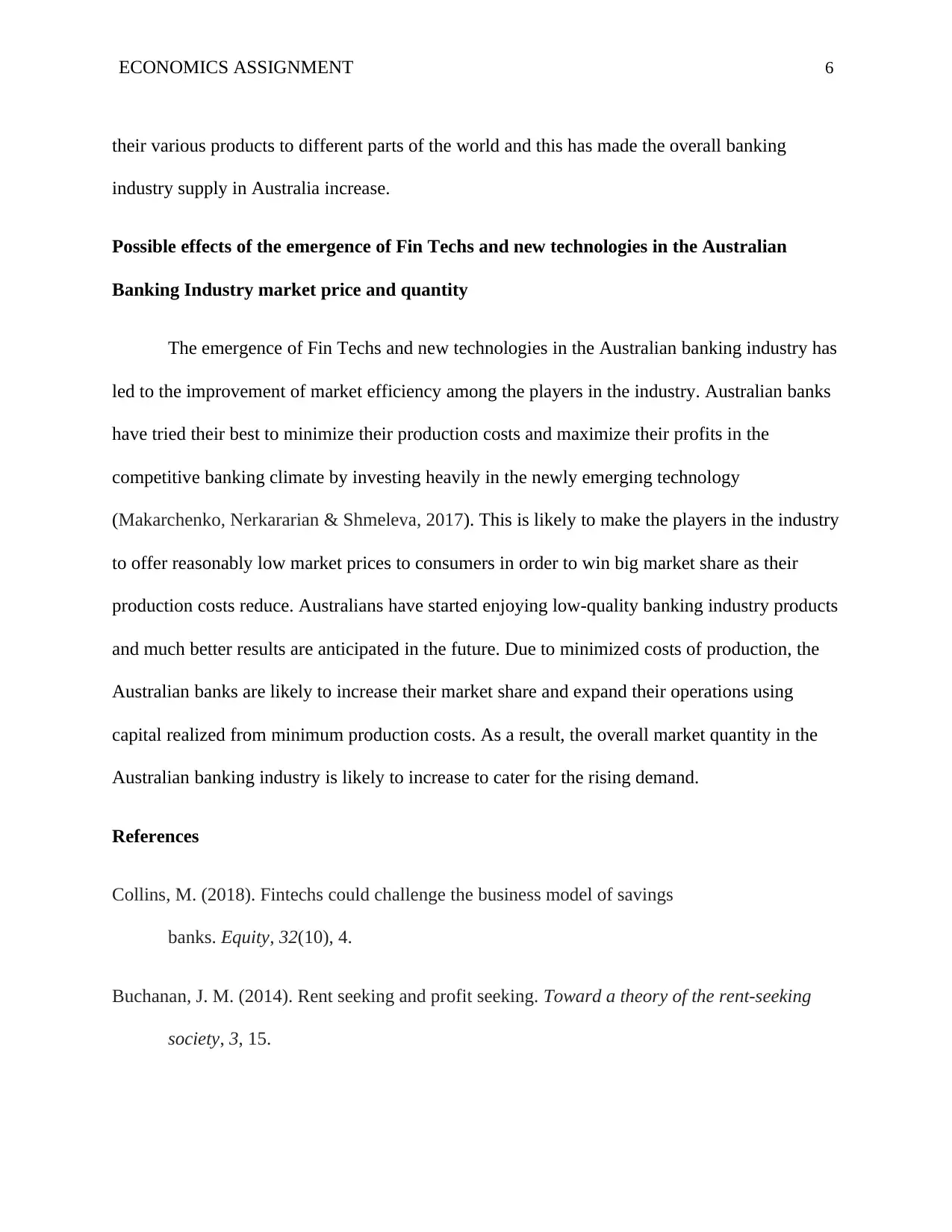
ECONOMICS ASSIGNMENT 6
their various products to different parts of the world and this has made the overall banking
industry supply in Australia increase.
Possible effects of the emergence of Fin Techs and new technologies in the Australian
Banking Industry market price and quantity
The emergence of Fin Techs and new technologies in the Australian banking industry has
led to the improvement of market efficiency among the players in the industry. Australian banks
have tried their best to minimize their production costs and maximize their profits in the
competitive banking climate by investing heavily in the newly emerging technology
(Makarchenko, Nerkararian & Shmeleva, 2017). This is likely to make the players in the industry
to offer reasonably low market prices to consumers in order to win big market share as their
production costs reduce. Australians have started enjoying low-quality banking industry products
and much better results are anticipated in the future. Due to minimized costs of production, the
Australian banks are likely to increase their market share and expand their operations using
capital realized from minimum production costs. As a result, the overall market quantity in the
Australian banking industry is likely to increase to cater for the rising demand.
References
Collins, M. (2018). Fintechs could challenge the business model of savings
banks. Equity, 32(10), 4.
Buchanan, J. M. (2014). Rent seeking and profit seeking. Toward a theory of the rent-seeking
society, 3, 15.
their various products to different parts of the world and this has made the overall banking
industry supply in Australia increase.
Possible effects of the emergence of Fin Techs and new technologies in the Australian
Banking Industry market price and quantity
The emergence of Fin Techs and new technologies in the Australian banking industry has
led to the improvement of market efficiency among the players in the industry. Australian banks
have tried their best to minimize their production costs and maximize their profits in the
competitive banking climate by investing heavily in the newly emerging technology
(Makarchenko, Nerkararian & Shmeleva, 2017). This is likely to make the players in the industry
to offer reasonably low market prices to consumers in order to win big market share as their
production costs reduce. Australians have started enjoying low-quality banking industry products
and much better results are anticipated in the future. Due to minimized costs of production, the
Australian banks are likely to increase their market share and expand their operations using
capital realized from minimum production costs. As a result, the overall market quantity in the
Australian banking industry is likely to increase to cater for the rising demand.
References
Collins, M. (2018). Fintechs could challenge the business model of savings
banks. Equity, 32(10), 4.
Buchanan, J. M. (2014). Rent seeking and profit seeking. Toward a theory of the rent-seeking
society, 3, 15.
⊘ This is a preview!⊘
Do you want full access?
Subscribe today to unlock all pages.

Trusted by 1+ million students worldwide
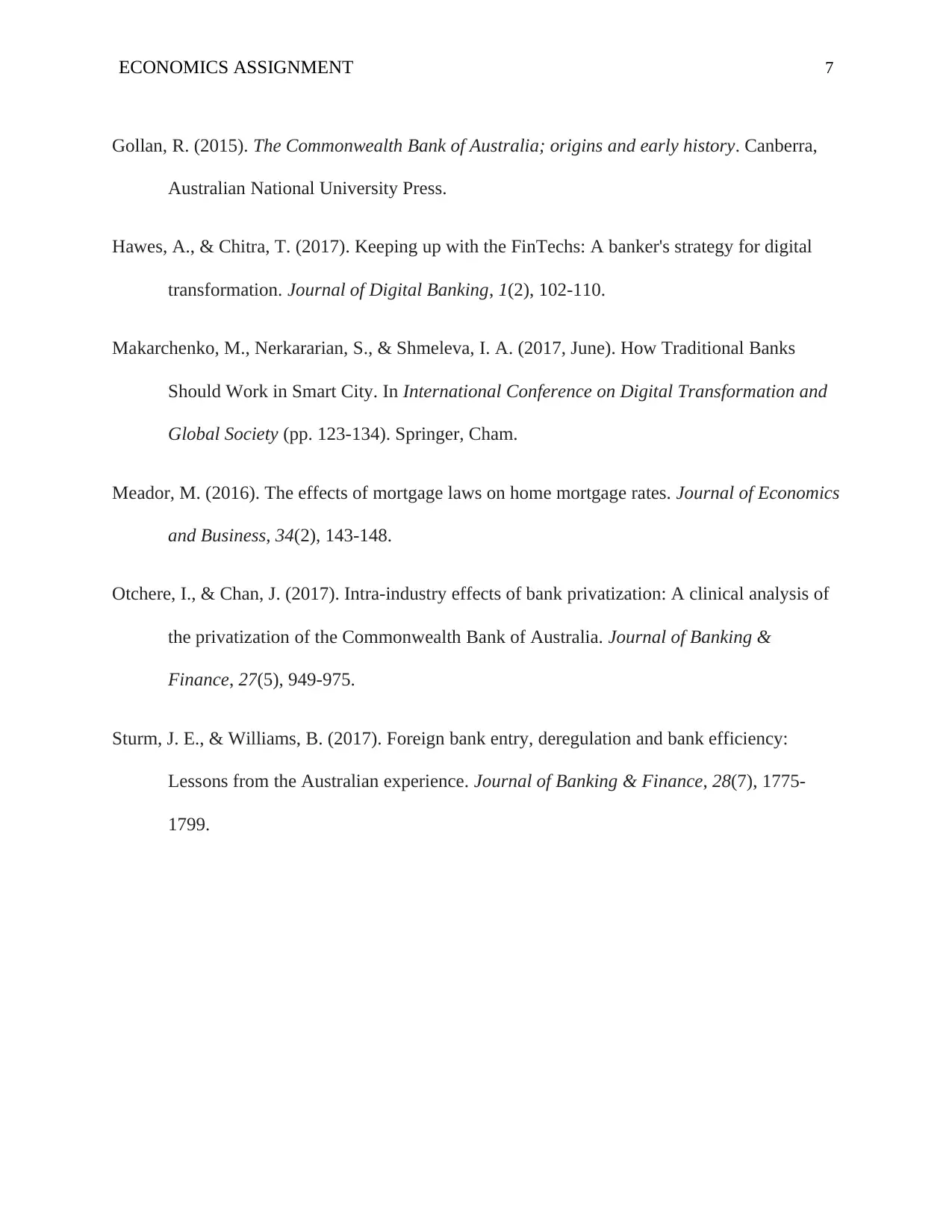
ECONOMICS ASSIGNMENT 7
Gollan, R. (2015). The Commonwealth Bank of Australia; origins and early history. Canberra,
Australian National University Press.
Hawes, A., & Chitra, T. (2017). Keeping up with the FinTechs: A banker's strategy for digital
transformation. Journal of Digital Banking, 1(2), 102-110.
Makarchenko, M., Nerkararian, S., & Shmeleva, I. A. (2017, June). How Traditional Banks
Should Work in Smart City. In International Conference on Digital Transformation and
Global Society (pp. 123-134). Springer, Cham.
Meador, M. (2016). The effects of mortgage laws on home mortgage rates. Journal of Economics
and Business, 34(2), 143-148.
Otchere, I., & Chan, J. (2017). Intra-industry effects of bank privatization: A clinical analysis of
the privatization of the Commonwealth Bank of Australia. Journal of Banking &
Finance, 27(5), 949-975.
Sturm, J. E., & Williams, B. (2017). Foreign bank entry, deregulation and bank efficiency:
Lessons from the Australian experience. Journal of Banking & Finance, 28(7), 1775-
1799.
Gollan, R. (2015). The Commonwealth Bank of Australia; origins and early history. Canberra,
Australian National University Press.
Hawes, A., & Chitra, T. (2017). Keeping up with the FinTechs: A banker's strategy for digital
transformation. Journal of Digital Banking, 1(2), 102-110.
Makarchenko, M., Nerkararian, S., & Shmeleva, I. A. (2017, June). How Traditional Banks
Should Work in Smart City. In International Conference on Digital Transformation and
Global Society (pp. 123-134). Springer, Cham.
Meador, M. (2016). The effects of mortgage laws on home mortgage rates. Journal of Economics
and Business, 34(2), 143-148.
Otchere, I., & Chan, J. (2017). Intra-industry effects of bank privatization: A clinical analysis of
the privatization of the Commonwealth Bank of Australia. Journal of Banking &
Finance, 27(5), 949-975.
Sturm, J. E., & Williams, B. (2017). Foreign bank entry, deregulation and bank efficiency:
Lessons from the Australian experience. Journal of Banking & Finance, 28(7), 1775-
1799.
1 out of 7
Related Documents
Your All-in-One AI-Powered Toolkit for Academic Success.
+13062052269
info@desklib.com
Available 24*7 on WhatsApp / Email
![[object Object]](/_next/static/media/star-bottom.7253800d.svg)
Unlock your academic potential
Copyright © 2020–2025 A2Z Services. All Rights Reserved. Developed and managed by ZUCOL.




